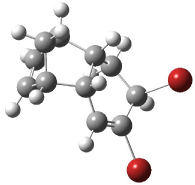Here as an interesting, relatively straightforward example of how modern computational methods can help elucidate a reaction mechanism. Brinker1 examined the thermolysis of (1S,2R,5R,7S,8R)-4,5-dibromotricyclo[6.2.1.02,7]undeca-3,9-diene 1. The observed products were cyclopentadiene (and its dimer), bromobenzene and (1R,2S,6S,7R,10R)-1,10-dibromotricyclo[5.2.2.02,6]undeca-3,8-diene
2. They proposed two possible mechanisms to account for these products. In the first mechanism, 1 can convert to 2 via a Cope rearrangement (path a, Scheme 1). The alternative mechanism has 1 undergo a retro-Diels-Alder reaction to produce 1,6-dibromo-1,3-cyclohexadiene 3 and cyclopentadiene 4 (path b, Scheme 1) 3 can then lose HBR to give bromobenzene. But more interesting is the possibility that cyclopentadiene and 3 can undergo a Diels-Alder reaction (path c, Scheme 1), but one with role reversal, i.e. cylopentadiene acts as the dienophile here, rather than the diene component as in the reverse of path b. This second Diels-Alder reaction (path c) produces 2.
Scheme 1

Brinker optimized the structures in Scheme 1, along with the transition states from paths a-c, at B3LYP/6-31G(d). These structures are shown in Figure 1 and their relative energies are listed in Table 1. The Cope rearrangement is favored over the retro-Diels-Alder by 3.6 kcal mol-1. While the subsequent Diels-Alder step (path c) has a low electronic barrier (21.7 kcal mol-1), it is enthalpically disfavored and the free energy barrier is high (40.4 kcal mol-1. Thus, formation of 2 derives mostly from the direct Cope rearrangement of 2. Production of bromobenzene from 2 results from the retro-Diels-Alder (path b) followed by loss of HBr.
Table 1. Electronic and Free Energies (kcal mol-1) computed at B3LYP/6-31G(d).1
|
|
||
| ΔE | ΔG412 | |
|
|
||
| 1 | 0.0 | 0.0 |
| TS(a) | +30.4 | +30.6 |
| 2 | -7.9 | -7.3 |
| TS(b) | +36.0 | +34.2 |
| 3 + 4 | +10.9 | -8.4 |
| TS(c) | +33.7 | +32.0 |
|
|
||
|
1 |
|
|
TS(a) |
TS(b) |
|
TS(c) |
|
Figure 1. B3LYP/6-31G(d) optimized structures.1
InChI:
1: InChI=1/C11H12Br2/c12-10-4-8-6-1-2-7(3-6)9(8)5-11(10)13/h1-2,4,6-9,11H,3,5H2/t6-,7+,8-,9+,11-/m1/s1
2: InChI=1/C11H12Br2/c12-10-6-7-4-5-11(10,13)9-3-1-2-8(7)9/h1,3-5,7-10H,2,6H2/t7-,8+,9+,10+,11+/m0/s1
References
(1) Su, K. J.; Mieusset, J. L.; Arion, V. B.; Brecker, L.; Brinker, U. H., “Cope Rearrangement versus a Novel Tandem Retro-Diels-Alder-Diels-Alder Reaction with Role reversal,” Org. Lett. 2007, 9, 113-115, DOI: 10.1021/ol0626793





